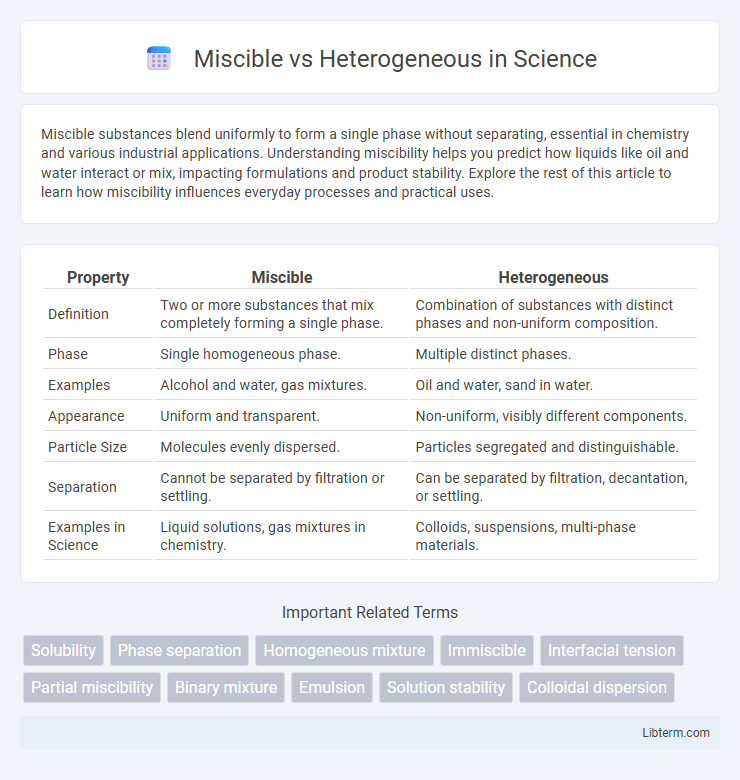Miscible substances blend uniformly to form a single phase without separating, essential in chemistry and various industrial applications. Understanding miscibility helps you predict how liquids like oil and water interact or mix, impacting formulations and product stability. Explore the rest of this article to learn how miscibility influences everyday processes and practical uses.
Table of Comparison
| Property | Miscible | Heterogeneous |
|---|---|---|
| Definition | Two or more substances that mix completely forming a single phase. | Combination of substances with distinct phases and non-uniform composition. |
| Phase | Single homogeneous phase. | Multiple distinct phases. |
| Examples | Alcohol and water, gas mixtures. | Oil and water, sand in water. |
| Appearance | Uniform and transparent. | Non-uniform, visibly different components. |
| Particle Size | Molecules evenly dispersed. | Particles segregated and distinguishable. |
| Separation | Cannot be separated by filtration or settling. | Can be separated by filtration, decantation, or settling. |
| Examples in Science | Liquid solutions, gas mixtures in chemistry. | Colloids, suspensions, multi-phase materials. |
Understanding Miscible and Heterogeneous Systems
Miscible systems consist of two or more substances that blend uniformly at the molecular level, forming a single homogeneous phase, such as alcohol and water. Heterogeneous systems contain multiple distinct phases, where the components retain separate identities and can be visually distinguished, like oil and water mixtures. Understanding the molecular interactions in miscible systems versus the phase separation in heterogeneous systems is crucial for applications in chemistry, material science, and chemical engineering.
Key Differences: Miscible vs. Heterogeneous
Miscible substances form homogeneous mixtures where components blend uniformly at the molecular level, such as alcohol and water. Heterogeneous mixtures consist of physically distinct parts with non-uniform composition, like oil and water or sand in water. Key differences lie in uniformity, particle distribution, and phase separation, with miscible mixtures showing single-phase behavior and heterogeneous mixtures displaying multiple phases.
Chemical and Physical Properties
Miscible substances form a homogeneous solution where their molecules mix uniformly, exhibiting consistent chemical and physical properties such as solvent-solute interactions and uniform boiling points. Heterogeneous mixtures consist of distinct phases with different chemical compositions and physical properties, like varied particle sizes or densities, resulting in non-uniform characteristics. Understanding miscibility is crucial for predicting solubility, phase behavior, and material compatibility in chemical processes.
Common Examples in Everyday Life
Oil and water represent common heterogeneous mixtures where components remain distinct and separate. Air and alcohol mixed with water showcase miscible mixtures that form uniform solutions throughout. Understanding these examples clarifies how miscibility influences the behavior and appearance of everyday substances.
Applications in Industry and Science
Miscible substances, such as ethanol and water, are widely used in pharmaceutical formulations and chemical manufacturing due to their ability to form uniform solutions, enhancing reaction efficiency and product consistency. Heterogeneous mixtures, like oil and water, are essential in industries such as food processing and petrochemicals where phase separation allows for processes like emulsification and extraction. Understanding the miscibility of components enables optimization of industrial applications ranging from solvent selection to material synthesis in scientific research.
Factors Affecting Miscibility and Heterogeneity
Miscibility depends on factors such as temperature, pressure, and molecular polarity, where similar polarity and increased temperature often enhance fluid mixing at the molecular level. Heterogeneity arises from differences in particle size, phase distribution, and intermolecular forces, causing visibly distinct phases or components to coexist. Understanding the interplay of molecular interactions and thermodynamic conditions is crucial for controlling miscibility and heterogeneity in chemical systems.
Methods for Identifying Mixture Types
Microscopic examination and spectroscopy techniques effectively distinguish between miscible and heterogeneous mixtures by analyzing particle distribution and molecular interactions. Density gradient centrifugation separates components based on density differences, confirming heterogeneity in mixtures with distinct phases. Chromatography further aids identification by separating mixture components, revealing uniformity in miscible mixtures versus distinct separation in heterogeneous ones.
Impacts on Solution Behavior
Miscible substances form a homogeneous mixture with uniform composition and consistent physical properties, leading to predictable solution behavior such as uniform diffusion rates and stable solubility. In contrast, heterogeneous mixtures exhibit phase separation and variable composition, causing irregular solubility patterns and uneven mass transfer rates. These differences significantly influence the efficiency and stability of chemical reactions and material processing.
Challenges in Separation and Purification
Miscible mixtures present significant challenges in separation and purification due to the complete uniform blending of components at the molecular level, making conventional mechanical separation ineffective. Techniques such as distillation, chromatography, or membrane separation often require precise control of temperature, pressure, or material properties to selectively isolate substances. In contrast, heterogeneous mixtures allow easier separation through physical means like filtration or decantation, but challenges arise when the particle sizes or phases are finely dispersed, complicating complete purification.
Future Trends in Mixture Research
Future trends in mixture research emphasize advanced characterization techniques and machine learning algorithms to better predict miscibility and phase behavior in complex systems. Innovations in nanotechnology and materials science are fostering the development of smart mixtures with tailored heterogeneous properties for applications in pharmaceuticals and energy storage. Increasing computational power enables more accurate simulation of molecular interactions, accelerating the design of optimized miscible blends for sustainable industrial processes.
Miscible Infographic

 libterm.com
libterm.com